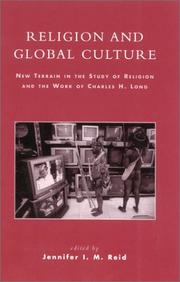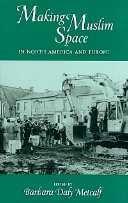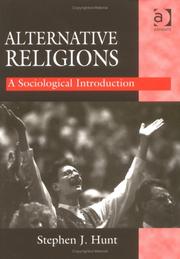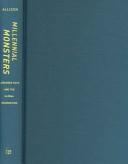| Listing 1 - 9 of 9 |
Sort by
|

ISBN: 0739105523 0739160168 9780739160169 9780739105528 9780739108109 0739108107 Year: 2003 Publisher: Lanham Lexington books
Abstract | Keywords | Export | Availability | Bookmark
 Loading...
Loading...Choose an application
- Reference Manager
- EndNote
- RefWorks (Direct export to RefWorks)
Religion and Global Culture draws together the work of a group of historians of religion who are concerned with situating the contemporary study of religion within the cultural complexity of the modern world. The writing of each of the volume's contributors relates to the work of leading historian of religion Charles H. Long, who has identified religious meanings in the contacts and exchanges of the colonial and postcolonial periods. Together with Long, these scholars explore religious practices in a variety of globalized contexts; chapters consider such varied subjects as the rituals of Afric
Globalization --- Religion and culture --- 291 --- Culture and religion --- Culture --- Religious aspects --- Godsdienstwetenschap: vergelijkend --- Long, Charles H. --- Long, Charles Houston --- Religion and culture. --- Religious aspects. --- religion --- global culture --- Charles H. Long --- history of religion --- colonialism --- postcolonialism --- ritual --- migration --- religious experience
Book
ISBN: 1526114224 9781526114228 9781526114235 1526114232 9781526114204 9781526114211 Year: 2019 Publisher: Manchester
Abstract | Keywords | Export | Availability | Bookmark
 Loading...
Loading...Choose an application
- Reference Manager
- EndNote
- RefWorks (Direct export to RefWorks)
This volume brings together a range of writers from different academic disciplines and different locations to provide an engaging and accessible critical exploration of one of the most revered and reviled bands in the history of popular music. The essays collated here locate The Clash in their own explosive cultural moment of punk's year zero and examine how the group speaks from beyond the grave to the uncanny parallels of other moments of social and political crisis. In addition, the collection considers the impact of the band in a range of different geopolitical contexts, with various contributors exploring what the band meant in settings as diverse as Italy, England, Northern Ireland, Australia and the United States. The diverse essays gathered in Working for the clampdown cast a critical light on both the cultural legacy and contemporary resonance of one of the most influential bands ever to have graced a stage.
Punk culture. --- Music --- Music and society --- Subculture --- Cyberpunk culture --- Social aspects. --- Clash (Musical group) --- The Clash (Musical group) --- 1970s London. --- Global culture. --- Politics and music. --- Popular music. --- Punk misic. --- Punk music. --- Radical politics. --- The Clash.
Book
ISBN: 1282556231 9786612556234 0520945387 Year: 2010 Publisher: Berkeley : University of California Press,
Abstract | Keywords | Export | Availability | Bookmark
 Loading...
Loading...Choose an application
- Reference Manager
- EndNote
- RefWorks (Direct export to RefWorks)
Illuminating one thousand years of history, The Pilgrim Art explores the remarkable cultural influence of Chinese porcelain around the globe. Cobalt ore was shipped from Persia to China in the fourteenth century, where it was used to decorate porcelain for Muslims in Southeast Asia, India, Persia, and Iraq. Spanish galleons delivered porcelain to Peru and Mexico while aristocrats in Europe ordered tableware from Canton. The book tells the fascinating story of how porcelain became a vehicle for the transmission and assimilation of artistic symbols, themes, and designs across vast distances-from Japan and Java to Egypt and England. It not only illustrates how porcelain influenced local artistic traditions but also shows how it became deeply intertwined with religion, economics, politics, and social identity. Bringing together many strands of history in an engaging narrative studded with fascinating vignettes, this is a history of cross-cultural exchange focused on an exceptional commodity that illuminates the emergence of what is arguably the first genuinely global culture.
Porcelain industry --- Porcelain, Chinese --- Porcelain --- Art and society. --- Social aspects --- History. --- 14th century. --- art and politics. --- art. --- artistic symbols. --- artistic traditions. --- artists. --- canton. --- china. --- chinese porcelain. --- cobalt ore. --- cross cultural exchange. --- designs. --- discussion books. --- economic shifts. --- egypt. --- england. --- europe. --- global art. --- global culture. --- historical. --- india. --- iraq. --- japan. --- java. --- merchant ships. --- mexico. --- muslim art. --- persia. --- peru. --- pilgrim art. --- porcelain. --- religion. --- social identity. --- southeast asia. --- spain. --- traditional porcelain. --- world history.

ISBN: 0520204034 0520204042 9780520204041 0585091420 052091743X 9780520917439 9780585091426 9780520204034 Year: 1996 Volume: 22 Publisher: Berkeley University of California Press
Abstract | Keywords | Export | Availability | Bookmark
 Loading...
Loading...Choose an application
- Reference Manager
- EndNote
- RefWorks (Direct export to RefWorks)
Focusing on the private and public use of space, this volume explores the religious life of the new Muslim communities in North America and Europe. Unlike most studies of immigrant groups, these essays concentrate on cultural practices and expressions of everyday life rather than on the political issues that dominate today's headlines. The authors emphasize the cultural strength and creativity of communities that draw upon Islamic symbols and practices to define "Muslim space" against the background of a non-Muslim environment. -- The range of perspectives is broad, encompassing middle-class professionals, mosque congregations, factory workers in France and the north of England, itinerant African traders, and prison inmates in New York. The truism that "Islam is a religion of the word" takes on concrete meaning as these disparate communities find ways to elaborate word-centered ritual and to have the visual and aural presence of sacred words in the spaces they inhabit. -- Publisher description.
Islam --- North America --- Europe --- Muslims --- Religion --- Philosophy & Religion --- Mohammedans --- Moors (People) --- Moslems --- Muhammadans --- Musalmans --- Mussalmans --- Mussulmans --- Mussulmen --- Mohammedanism --- Muhammadanism --- Muslimism --- Mussulmanism --- Religious adherents --- Religions --- Muslims - North America. --- Muslims - North America --- Muslims - Europe --- anthropology. --- claiming space. --- community. --- comparative studies on muslim societies series. --- cultural practices. --- ethnicity. --- europe. --- everyday ritual. --- global culture. --- immigrant groups. --- islam. --- islamic symbols. --- migrant communities. --- mosque congregation. --- muslim identity. --- muslim space. --- muslim world day parade. --- muslim. --- nationalism. --- north america. --- prison mosque. --- private space. --- public use of space. --- religion. --- religious life. --- religious studies. --- sacred space. --- world religion.
Book
ISBN: 1280115750 9786613520753 0520951824 9780520951822 9781280115752 9780520268982 0520268989 Year: 2012 Publisher: Berkeley University of California Press
Abstract | Keywords | Export | Availability | Bookmark
 Loading...
Loading...Choose an application
- Reference Manager
- EndNote
- RefWorks (Direct export to RefWorks)
This insightful book tracks the concept of culture across a range of scholarly disciplines and much of the twentieth and early twenty-first centuries-years that saw the emergence of new fields and subfields (cultural studies, the new cultural history, literary new historicism, as well as ethnic and minority studies) and came to be called "the cultural turn." Since the 1990's, however, the idea of culture has fallen out of scholarly favor. Susan Hegeman engages with a diversity of disciplines, including anthropology, literary studies, sociology, philosophy, psychology, and political science, to historicize the rise and fall of the cultural turn and to propose ways that culture may still be a vital concept in the global present.
Culture and globalization. --- Critical theory. --- Mass media and culture. --- Popular culture --- Culture --- Globalization and culture --- Globalization --- Critical social theory --- Critical theory (Philosophy) --- Critical theory (Sociology) --- Negative philosophy --- Criticism (Philosophy) --- Philosophy, Modern --- Rationalism --- Sociology --- Frankfurt school of sociology --- Socialism --- Culture and mass media --- Cultural studies --- Study and teaching. --- 20th century culture. --- 20th century sociology. --- 21st century culture. --- 21st century sociology. --- american studies. --- anthropology. --- concept of culture. --- cultural anthropology. --- cultural history. --- cultural scholars. --- cultural studies resource. --- cultural studies. --- ethnic studies. --- evolution of culture. --- global culture. --- human condition. --- human sciences. --- literary movements and periods. --- literary new historicism. --- literary studies. --- minority studies. --- modern culture. --- modernism. --- philosophy. --- political science. --- psychology. --- sociology.

ISBN: 0754634108 0754634094 9780754634102 9780754634096 Year: 2003 Publisher: Aldershot Ashgate
Abstract | Keywords | Export | Availability | Bookmark
 Loading...
Loading...Choose an application
- Reference Manager
- EndNote
- RefWorks (Direct export to RefWorks)
Cults. --- Sects. --- Religions. --- Religion and sociology. --- Christianity and other religions. --- Cultes --- Sectes --- Religions --- Sociologie religieuse --- Christianisme --- Relations --- 298 --- 298.9 --- 289 --- 316:2 --- Christianity --- Christianity and other religions --- Syncretism (Christianity) --- Religion and society --- Religious sociology --- Society and religion --- Sociology, Religious --- Sociology and religion --- Sociology of religion --- Sociology --- Comparative religion --- Denominations, Religious --- Religion, Comparative --- Religions, Comparative --- Religious denominations --- World religions --- Civilization --- Gods --- Religion --- Religions, Modern --- Cults --- Alternative religious movements --- Cult --- Cultus --- Marginal religious movements --- New religions --- New religious movements --- NRMs (Religion) --- Religious movements, Alternative --- Religious movements, Marginal --- Religious movements, New --- Sects --- Niet-christelijke Europese godsdiensten --- Recente niet-christelijke of afgeleid-christelijke religies; New Age --- Andere christelijke sekten --- Godsdienstsociologie --- History --- 316:2 Godsdienstsociologie --- 298.9 Recente niet-christelijke of afgeleid-christelijke religies; New Age --- Religion and sociology --- alternative religions --- the post-Christian society --- beliefs, practices and significance of alternative religions --- public and legal controversies --- secularisation, post-modernity, religion, healing, human potential --- changes in global culture --- Christian fundamentalism --- neo-paganism --- new religious movements (NRM) --- Pentecostalism

ISSN: 15557812 ISBN: 1282771922 9786612771927 0520938992 1601290292 9780520938991 1423771125 9781423771128 9781601290298 9780520221482 0520221486 9780520245655 0520245652 9781282771925 6612771925 Year: 2006 Volume: 13 Publisher: Berkeley University of California Press
Abstract | Keywords | Export | Availability | Bookmark
 Loading...
Loading...Choose an application
- Reference Manager
- EndNote
- RefWorks (Direct export to RefWorks)
From sushi and karaoke to martial arts and technoware, the currency of made-in-Japan cultural goods has skyrocketed in the global marketplace during the past decade. The globalization of Japanese "cool" is led by youth products: video games, manga (comic books), anime (animation), and cute characters that have fostered kid crazes from Hong Kong to Canada. Examining the crossover traffic between Japan and the United States, Millennial Monsters explores the global popularity of Japanese youth goods today while it questions the make-up of the fantasies and the capitalistic conditions of the play involved. Arguing that part of the appeal of such dream worlds is the polymorphous perversity with which they scramble identity and character, the author traces the postindustrial milieux from which such fantasies have arisen in postwar Japan and been popularly received in the United States.
Toys --- Games --- Animated films --- Video games --- Consumer goods --- Toy industry --- Philosophy, Japanese. --- Japanese philosophy --- Amusements --- Children's paraphernalia --- Infants' supplies --- Miniature objects --- Leisure industry --- Consumer products --- Consumers' goods --- Goods, Consumer --- Commercial products --- Television games --- Videogames --- Electronic games --- Games, Japanese --- Marketing. --- Japan --- Social life and customs. --- Philosophy, Japanese --- J6852 --- Marketing --- Japan: Games, toys and hobbies -- toys --- 745.036 --- 745.04 --- animatie --- animatiefilms --- anime --- Anne Allison ; Foreword by Gary Cross --- beeldverhaal --- cultuurgeschiedenis --- design --- eenentwintigste eeuw --- games --- globalisering --- manga --- popcultuur --- speelgoed --- tekenkunst --- twintigste eeuw --- Verenigde Staten --- videospellen --- virtual reality --- Jouets --- Jeux --- Dessins animés --- Jeux vidéo --- Biens de consommation --- Philosophie japonaise --- Industrie --- Commercialisation --- Japon --- Social life and customs --- Moeurs et coutumes --- Toys - Japan --- Games - Japan --- Animated films - Japan --- Video games - Japan --- Consumer goods - Japan --- Toy industry - Japan --- Toys - Japan - Marketing --- Japan - Social life and customs --- Computer games --- Internet games --- america. --- animation. --- anime. --- canada. --- capitalism. --- comic books. --- cultural goods. --- cultural studies. --- global consumption. --- global culture. --- global imagination. --- global marketplace. --- globalization. --- hong kong. --- japan. --- japanese culture. --- japanese toys. --- karaoke. --- made in japan. --- manga. --- martial arts. --- media studies. --- millennials. --- nonfiction. --- popular toys. --- postindustrial. --- postwar japan. --- social science. --- sushi. --- technoware. --- toy industry. --- united states. --- video games. --- youth products.
Book
ISBN: 9780520282520 9780520282513 9780520958289 0520958284 1306923611 9781306923613 0520282515 0520282523 Year: 2014 Publisher: Oakland, Calif. University of California Press
Abstract | Keywords | Export | Availability | Bookmark
 Loading...
Loading...Choose an application
- Reference Manager
- EndNote
- RefWorks (Direct export to RefWorks)
In this groundbreaking ethnography, Ruben Andersson, a gifted anthropologist and journalist, travels along the clandestine migration trail from Senegal and Mali to the Spanish North African enclaves of Ceuta and Melilla. Through the voices of his informants, Andersson explores, viscerally and emphatically, how Europe's increasingly powerful border regime meets and interacts with its target-the clandestine migrant. This vivid, rich work examines the subterranean migration flow from Africa to Europe, and shifts the focus from the "illegal immigrants" themselves to the vast industry built around their movements. This fascinating and accessible book is a must-read for anyone interested in the politics of international migration and the changing texture of global culture.
Illegal aliens --- Immigrants clandestins --- Ceuta (Spain) --- Melilla (Spain) --- Mali --- Senegal --- Ceuta (Espagne) --- Melilla (Espagne) --- Sénégal --- Emigration and immigration --- Emigration et immigration --- SOCIAL SCIENCE / Anthropology / Cultural. --- SOCIAL SCIENCE / Emigration & Immigration. --- #SBIB:39A6 --- Aliens --- Aliens, Illegal --- Illegal immigrants --- Illegal immigration --- Undocumented aliens --- Alien detention centers --- Human smuggling --- Etniciteit / Migratiebeleid en -problemen --- Legal status, laws, etc. --- Social science --- Anthropology --- Cultural. --- Emigration & Immigration. --- Sénégal --- Undocumented immigrants --- R.M. (République du Mali) --- RM (République du Mali) --- République du Mali --- Mali ka Fasojamana --- مالي --- Малі --- Рэспубліка Малі --- Rėspublika Mali --- Мали --- Република Мали --- Republika Mali --- Μάλι --- Δημοκρατία του Μάλι --- Dēmokratia tou Mali --- מאלי --- רפובליקת מאלי --- Republiḳat Mali --- 말리 --- Malli --- 말리 공화국 --- Malli Konghwaguk --- マリ共和国 --- Mari Kyōwakoku --- Республика Мали --- Республіка Малі --- Cộng hòa Mali --- 马里共和国 --- Mali Gongheguo --- マリ --- Mari --- Sudanese Republic --- Melilla, Morocco --- Rusadir (Spain) --- Rusaddir (Spain) --- M'lila (Spain) --- Millela (Spain) --- Malīlīyah (Spain) --- Malīlyah (Spain) --- Ciudad Autónoma de Melilla (Spain) --- Ceuta --- Sabtah (Spain) --- Cepta (Spain) --- Ceupta (Spain) --- Cevta (Spain) --- Sebta (Spain) --- Sinighāl --- Territoire du Sénégal --- Gouvernement du Sénégal --- Republic of Senegal --- République du Sénégal --- Gouvernement de la République du Sénégal --- Saaxle Senegaal --- Réewum Senegaal --- Republiek van Senegal --- سنغال --- Republica de Senegal --- Rèpublica du Sènègal --- Seneqal --- Seneqal Respublikası --- Сенегал --- Senehal --- Рэспубліка Сенегал --- Rėspublika Senehal --- Republik Senegal --- Republika Senegal --- República del Senegal --- Senegalská republika --- Gweriniaeth Sénégal --- Senegali Vabariik --- Σενεγαλη --- Senegalē --- Δημοκρατια της Σενεγαλης --- Dēmokratia tēs Senegalēs --- セネガル --- Senegaru --- French Sudan --- Mali Federation --- Africa, French-speaking West --- Emigration and immigration. --- SOCIAL SCIENCE / Anthropology / Cultural --- SOCIAL SCIENCE / Emigration & Immigration --- Enemy aliens --- Expatriates --- Foreign population --- Foreign residents --- Foreigners --- Non-citizens --- Noncitizens --- Resident aliens --- Unauthorized immigrants --- Unnaturalized foreign residents --- Persons --- Ciudad de Ceuta (Spain) --- Cueta (Spain) --- Septa (Spain) --- Septem Fratres (Spain) --- Russadir (Spain) --- Mřič (Spain) --- مليلية (Spain) --- Ciudad de Melilla (Spain) --- Children of illegal aliens --- Illegal alien children --- Irregular migration --- Unauthorized immigration --- Undocumented immigration --- Women illegal aliens --- Noncitizen detention centers --- Ciudad Autónoma de Ceuta (Spain) --- africa to europe. --- african migration. --- anthropology. --- border crossings. --- border regime. --- borderlands. --- california series in public anthropology. --- civic. --- clandestine migration trail. --- confrontations. --- cultural anthropology. --- cultural studies. --- emigration and immigration studies. --- ethnographic research. --- europe. --- global culture. --- global disaster. --- history. --- illegal immigrants. --- international drama. --- international migration. --- journalism. --- mali. --- migrants. --- migration. --- national security. --- politics. --- powerful border. --- senegal. --- subterranean migration. --- Migration. Refugees --- International private law --- Ethnology. Cultural anthropology --- Europe --- Africa
Book
ISBN: 9780415320320 9780415320313 9780415320337 9780415320306 9780415320290 Year: 2014 Publisher: London New York Routledge
Abstract | Keywords | Export | Availability | Bookmark
 Loading...
Loading...Choose an application
- Reference Manager
- EndNote
- RefWorks (Direct export to RefWorks)
Sociology --- cults --- new religious movements --- the cult --- the cultic milieu --- secularization --- cult formation --- revitalization movements --- charismatic leadership --- Hasidism --- Moonism --- charisma --- counterculture --- the People's Temple --- Babism --- Baha'ism --- militancy --- quietism --- conflation --- the construction of a religion --- Japanese new religions --- Gedatsu-kai --- Millenarianism --- the Apocalypse --- religious rivalry --- religious studies --- Heaven's Gate --- Branch Davidian --- Waco --- sacred narrative --- East-West dialogue --- mythmaking --- African American Muslims --- the Moorish Science Temple --- the Nation of Islam --- the American Society of Muslims --- neo-Sufism --- the Church of All Worlds --- science fiction --- environmentalism --- holistic Paganism --- the feminist spirituality movement --- the Easternisation of the West --- pluralism --- the American mainstream --- the World's Parliament of Religions --- Japan --- Japanese new religious movements --- conversion motifs --- neo-Paganism --- the Devil --- Satanism --- prophecy --- the Jehovah's Witnesses --- prophetic expectations --- decentered movements --- Rastafari --- charisma-based new religious movement --- the Baba Lovers --- hagiography --- the Aetherius Society --- the social construction of a religious leader --- New Age --- the discursive construction of community --- the Satsang network --- post-Osho phenomenon --- conversion --- brainwashing --- the Solar Temple --- secret religion --- the educated classes --- Scientology --- post-apostasy --- marketing charisma --- making religious celebrity in Ghana --- NRMs --- new religion --- new religions and alternative religions --- the relationship between scholars and the new religious movements --- Western Esotericism --- the science of religions --- superstition --- doctrine --- the return of the sacred --- the future of religion --- religion in modernity --- culture --- Russia --- Falun Gong --- politics --- China --- social change --- gender roles --- online religion --- the study of religious participation on the internet --- alternative spiritualities --- the reenchantment of the West --- Terence McKenna --- 2012 --- science --- contemporary spiritual movements in India --- religious dimensions of UFO phenomena --- new religious forms --- sacralization --- family structures --- feminist discourse on the scientific study of religion --- women in the Raelian movement --- gender and authority --- The Family International --- food practices --- social dynamics --- the Hare Krishna movement --- children in new religions --- duties of care --- charismatic groups --- Subud --- Javanese mysticism in the West --- media --- health --- lifestyle --- healing in new religious movements --- the Otherkin community --- the mass media --- Mormonism --- contemporary global culture --- race --- globalisation --- racism --- millennialism --- Cuban santeria --- Haitian Vodun --- Peurto Rican spiritualism --- multiculturalism --- syncretism --- Esotericism --- the Afro-Brazilian Candomblé --- globalization of Pentecostal Christianity --- globalization of charismatic Christianity --- fair game --- the Church of Scientology --- Paganism --- Humanism --- Unitarian Universalism --- sectarian converts --- ethnic orthodox churches in the United States --- cold war --- America
| Listing 1 - 9 of 9 |
Sort by
|

 Search
Search Feedback
Feedback About UniCat
About UniCat  Help
Help News
News